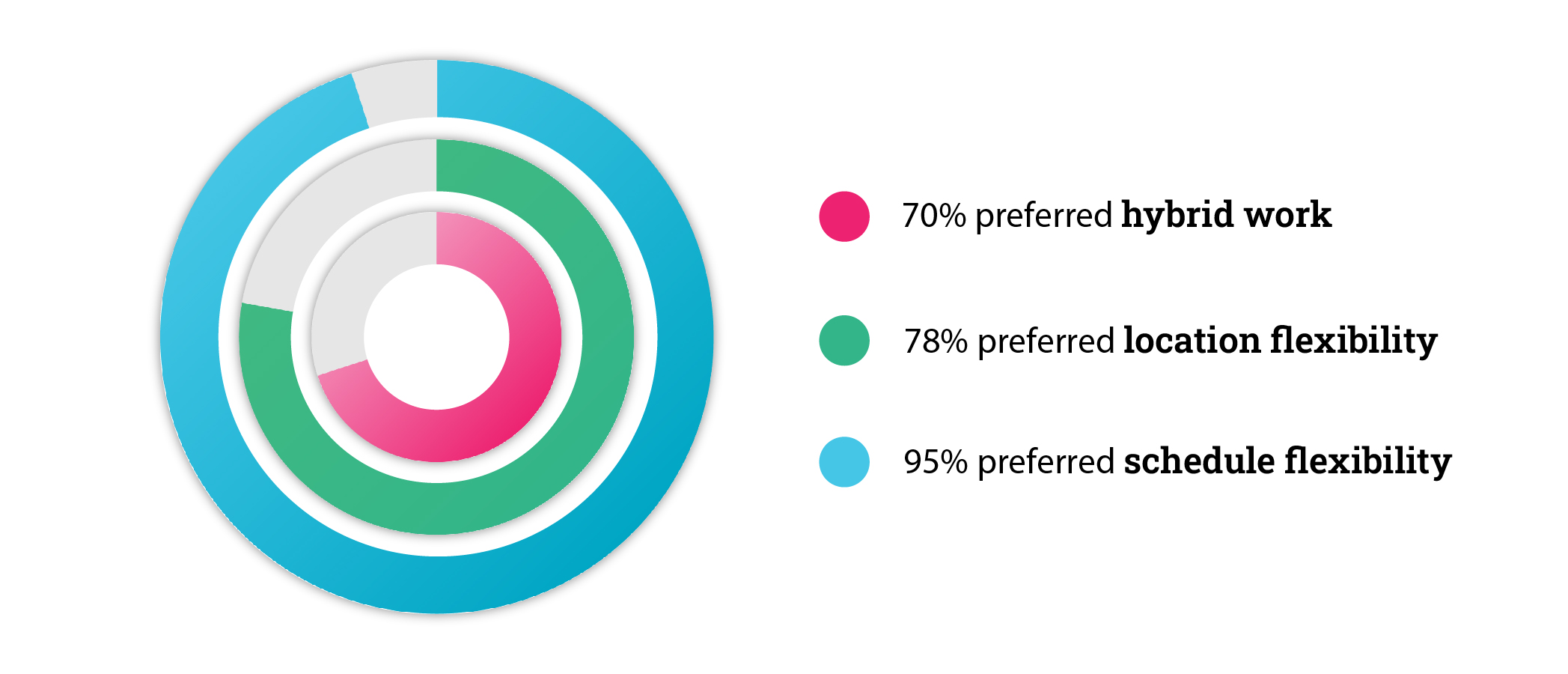For the past year, in nearly every conversation with executives we’ve been hearing: “Sooo…what are y’all doing about remote work? Are you asking everyone to come back into the office? Are you doing a hybrid work model? Is return-to-office affecting your productivity, team happiness, or culture?” We feel ya. We were struggling to navigate return-to-office, remote work, and hybrid work, too.
Being the nerds we are, we researched what other companies are doing, reviewed articles, and read the most highly regarded books on the topic:
For us, Remote not Distant had the most timely and relevant information. Stryve has integrated a lot of what the author recommends into our company’s policies and culture. We liked the book so much that we also made it Stryve’s Book of the Year for 2023 and will be sending copies of the book to our clients for our holiday gift this year. No, we don’t get any kickbacks from this book recommendation, haha. This is a 100% wholegrain goodness recommendation from us.
After all the research and internal discussions, we announced our hybrid work policies to our team in Fall 2022. After a year of being our hybrid work model and in the spirit of trying to help others navigate their remote, hybrid, and back-to-office plans, we want to share what we found.
Employees prefer flexibility
In our hybrid work policy, our team has the option to work remotely or come into the office whenever they want. Our office has no assigned seating. Team members can come in and grab any open desk for the day. We’re not concerned about where work is being done, but rather that the work is getting done.
A year after that announcement we’ve found that 80% of our team prefer to work remotely whereas 20% come into the office at least 2-3 times a week. This is in line with the macro trend we read about in Remote not Distant. In a global survey, 70% of respondents indicated that hybrid is their preferred work environment, 78% want location flexibility and nearly all respondents (95%) want schedule flexibility. Offering flexibility is a major competitive advantage that job candidates consider.

It seems like the benefits outweigh the costs when it comes to remote work flexibility vs. working in-person 100% of the time, so we couldn’t help but wonder why companies like Amazon, Google, and Apple were forcing their employees back to the office. From our conversations with friends at those companies, their employers say they want people back in the office because it’s best for collaboration and culture. But employees of those companies say forcing people back into the office is more about their employers needing to justify the high cost of a physical location or prescribing to the notion “If I ‘see’ that you’re working, you’re working”. This seems outdated considering we have innumerable collaboration and communication tools like Slack, Teams, Zoom, Jira, and Miro at our fingertips nowadays.
At Stryve, we feel that neither our productivity nor collaborative abilities have dropped off in a remote work model. Having said that, we can’t ignore the merits of in-office work and we do want to acknowledge that some studies indicate that remote work might not be as productive as once thought. Experts agree on one thing: the hybrid work model seems to be the sweet spot.
Setting Hybrid Model expectations
When we announced our hybrid work model to our team, we established the following guidelines.
You can work anywhere (with a few caveats)
Our team can work from anywhere if their job duties permit it with just a few requirements we’ll dive into shortly. There is no limit on the number of days per week or duration that an employee can work remotely. We’ve had one team member work from Costa Rica for a couple of months, another work from Guyana for a couple of weeks and others work across Canada to extend vacations and get a change of scenery.
Similarly, there’s no limit on the number of days per week or duration that an employee can work in the office. Stryve team members are always welcome to attend in person, except if:
- They’re sick
- There’s inclement weather
- Local Public Health guidelines or other extenuating circumstances require Stryve to close the office for safety reasons
Plan in advance
For employee safety and security reasons, we needed a system for knowing if a team member who usually works remotely is planning to work in the office. We ask that employees mark themselves “In Office” in Humi, our HR software.
The requirements for remote work set-up
Regardless of where our team is working from, they need the following:
- A high-speed Internet connection with at least 50Mbps connection speed.
- Being available on Slack during core working hours (8:30 am to 4:30 pm Eastern Time Zone).
- A high-quality camera and microphone. Stryvers are required to be on camera for remote meetings.
- An environment suitable to the work our team members are performing (for example, it might be challenging to be professional on a call from a loud coffee shop or the beach).
- Using a Stryve laptop with 2FA, LastPass and/or a VPN. Stryve’s technology policies apply no matter where a Stryver is working from.
- Team members need to track 7 hours of their day in Jira, our project management software. We review a team-wide time tracking report each week. If anyone isn’t doing their work, we’ll know quickly because their assigned tasks will be incomplete or their hours in Jira will be low.
Budget for setting up and maintaining a remote office
To help our team get their remote workspace set up, Stryve provides an initial Work from Home Benefit of $1,500 to set up their remote workspace and then $250 per year for ongoing work-from-home costs like office supplies and tech peripherals.
The flexibility of remote work comes with a tradeoff
While we don’t expect Stryve team members to work from the office full-time we do periodically hold company-wide meetings, social events, and client meetings where in-person attendance is strongly preferred if not required.
If we need our team to come to the office for an in-person meeting they have to get to the office at their own expense. This feels like a fair trade-off since no one is forced to come into the office regularly and fair to those who are local and come into the office, incurring daily commute costs.
Weekly team check-in
While working remotely during the pandemic, we found that junior team members felt bad getting in touch with senior team members about roadblocks they were encountering. The junior team members felt they might be bothering or interrupting senior members with their questions. You couldn’t just glance over to see if someone was focusing deeply on a task or in a meeting. We counteracted this in two ways. First, by requiring team members to update their Slack status when they’re in a meeting, on lunch, or focusing on something and not wanting to be interrupted. We also do a 30-minute team check-in meeting on Monday afternoons. Each week before our Monday Check-In, Stryvers write into a shared OneNote doc what their focus for the week is and if they need help with anything. We ask each team member if they need support or if they’re encountering a roadblock. If someone is stuck or overwhelmed, fellow team members can chime in to help set priorities or take something off that team member’s plate.
We trust you
The lynchpin in any hybrid work policy is that a company has to trust that they’ve hired employees who care about doing a good job. In our experience, if there’s a weak link in the chain in a company, it’ll become evident, regardless of whether they’re in-office or working remotely.
Foster culture regardless of location
A hybrid work policy will govern how work is to be done but to have a truly successful hybrid work system we had to make sure company culture and building trust among our team didn’t slip.
Traditionally, culture and trust feel like it’s best built by being in person with each other. Over the past three years, we’ve learned that you don’t need to be physically around each other every day or every week to foster a strong culture of trust at a company. Here’s how we build culture and trust through a hybrid model:
Psychological safety
Whether we’re working in person or remotely, it is important for team members to feel psychologically safe to be open and honest with each other. It’s been proven that the safer we feel to speak honestly with each other, the better results a company will achieve. There are many ways to foster psychological safety and it is a critical part of our culture.
Feel Good Fridays
Before the pandemic, when the Stryve team was in-office together full time, we’d stop work each Friday afternoon for Feel Good Friday. It was about an hour of social time just to hang out, chat, do a puzzle, or play a game together. Now that we’re in a hybrid work model we’ve moved Feel Good Fridays to a Teams call. It’s still social and lighthearted. We play games, find out what everyone is doing for the weekend, and celebrate the week’s accomplishments. Feel Good Friday is now the video call version of what we used to do in person.
Celebrating birthday lunches
When it’s a Stryve team member’s birthday we do virtual team lunches and eat together on a remote call. For these birthday lunches, each Stryve team member has a $30 expense account to buy themselves lunch. Stryvers look forward to trying out new food places on Stryve’s dime (we love food!) and it’s an opportunity to make team members feel special on their birthday.
Non-work-related Slack channels
We have non-work related social chat threads on Slack where people on our team share pics of their pets, what they’re listening to on Spotify, recipes they made, and talk about sports or concerts and much more. It’s a great way to get to know colleagues on a personal level.


Weekly Donuts
We integrated the Donut app into our Slack. The Donut app matches you with a fellow team member each week and asks you to set up a 15-minute meeting to connect one-on-one on a video call sometime in the coming week. The 15-minute chat is like grabbing a donut and a coffee with a colleague or bumping into them at a water cooler. The point of the chat is to just talk about non-work related things and get to know your colleague better.

Quarterly in-person day
Each quarter we get everyone together for a Stryve IRL Day. On those days, we discuss business strategies that affect the entire team, report on company performance, and then do a social activity together. These in-person days are a great way to get everyone energized about the company’s direction and create a team bond.
What’s next
Navigating anything in the past 3 years has been confusing, especially the transition between in-office, remote work, or hybrid work models. Given what we’ve heard, read, and experienced in the past year, we’re happy to say that after a lot of trial and error, we feel like we’re getting close to the sweet spot.
We’ve learned that a successful hybrid work model requires:
- Listening to and trusting your people
- Investing in the creation of policies that facilitate hybrid work
- A tech infrastructure that supports remote collaboration
- Maintaining psychological safety and ensuring there’s no shame around how individuals choose to work
- Being open to change and adapting existing ways of working









